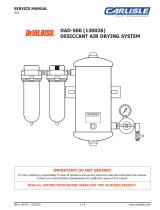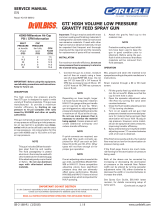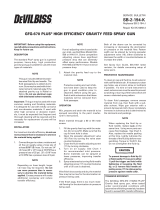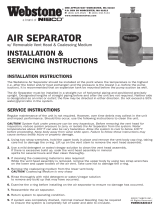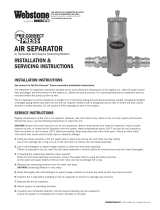
PAGE 2 SB-6-132-G
receptacle. Prevent vinyl tubing from
becoming kinked which would prevent
free movement of liquids discharged
from the automatic or manual drain.
8. An optional manual drain HAF-11) can
be installed in place of the automatic
drains.
INSTALLATION – MOUNTING BRACKETS
1. Use the mounting bracket as a template
for locating the mounting holes.
2. Drill appropriate sized holes through
booth wall as shown in Figure 2. Two
5/16" round head screws, nuts and lock-
washers are supplied. If mounting into
a solid or hollow wall, use anchors (not
included).
3. Assemble mounting bracket to wall,
positioning “L” bracket with top screw.
4. Tighten bottom screw firmly. Leave top
screw partially loose so “L” bracket can
slide up out of the way.
5. Place filter in the bracket, positioning
between curved saddle ears. See Figure
1 on Page 1.
6. Slide “L” bracket down against top of
filter, then firmly tighten the top screw.
SAFETY PRECAUTIONS
This manual contains important information that all users must know and understand before using the equipment. This information
relates to USER SAFETY and PREVENTING EQUIPMENT PROBLEMS.
To help you recognize this information, we use the following terms to draw your attention to certain equipment labels and portions of
this manual. Please pay special attention to any label or information that is highlighted by one of these terms:
Note
Information that you should pay
special attention to.
Important information that tells
how to prevent damage to equip-
ment,orhowtoavoida situation
that might cause minor injury.
Important information to alert
you to a situation that might cause
serious injury if instructions are not
followed.
INSTALLATION – AIR STATION
Riskofexplosionandinjury.Release
all air pressure from system before
servicing system. Be sure to read
andunderstandallServiceBulletins
on the separate components before
usingthesystem.Useonlyspecied
DeVilbiss parts.
Riskofequipmentdamage!Donot
install your air station where it is
subjected to sudden depressuriza-
tioncyclesexceeding20PSIG.Quick
relievingairsolenoidvalves,typical
in some spray booths, will eventually
failpressuregaugesandlters.
To minimize sudden depressurization effect,
replace the existing solenoid with a "slow
closing solenoid valve". (One source: Auto-
matic Switch Co). Or, install an air adjusting
valve at the existing solenoid valve outlet.
For ease of installation and maintenance,
attach the assembled air station to the main
air line using a pipe union, (not included).
1. Be sure to read all Warnings and Cautions
in this manual and component manuals
on the unit before installation or using
this equipment.
2. Install air station system as close as pos-
sible to the point where the air is being
used. Use enclosed mounting bracket
to support Air Station.
3. Install main shut-off valve (supplied by
user) upstream of air drying system to
allow maintenance to the unit.
4. Install unit with air flow through filter in
direction of arrow on top of filters.
5. Minimum 3/4" NPT piping is recom-
mended. Avoid using fittings, couplings,
etc. that restrict air flow.
6. Maximuminletpressureandoperating
temperature is: 150 PSIG and 120° F
(48.9 C)
7. Three 6' lengths of vinyl tubing are
shipped loose with the system. Slide
over drains which protrude from bot-
tom of the filters. Place the other
end of vinyl tubing into appropriate
Figure 2 – Mounting Bracket
5/16" Nuts
5/16"
Rd. Hd.
Machine
Screws
“L” Bracket
5/16" Lockwashers
Booth Wall
Mounting Bracket
Riskofillnessordeath.Carbonmon-
oxidecancausenausea,faintingor
death.Stopusingifcarbonmonoxide
ispresent.Thisunitdoesnotremove
carbonmonoxide.Acarbonmonox-
idemonitorshouldbeincorporated
into your air supply line to warn of the
presenceofcarbonmonoxide.
Risk of injury. Do not place unit in
service without metal bowl guard
installed. Filter units are sold only
withmetalbowlguards.Tominimize
thedangerofyingfragmentsinthe
eventofplasticbowlfailure,guard
mustnotberemoved.Iftheunitis
in service without the metal bowl
guardinstalled,manufacturer’swar-
rantiesarevoidandthemanufacturer
assumes no responsibility for any
resulting loss. If unit has been in
service and does not have a metal
bowl guard, order one and install
before placing back in service.
Certain compressor oils, cleaning
agentsandsolventsmayattackthe
plasticandrubbercomponentsused
intheconstructionofthisproduct.
Thisproductshouldnotbeusedin
conjunction with or in the vicinity
ofthesematerials.Readandfollow
material labels carefully. Please
consultDeVilbissifindoubt.









